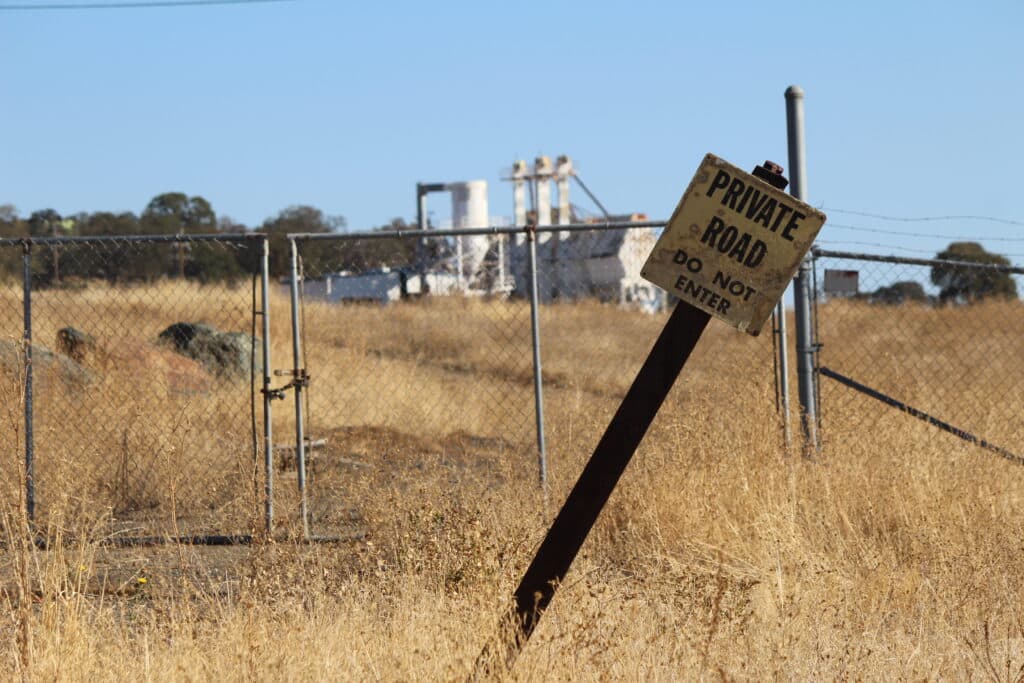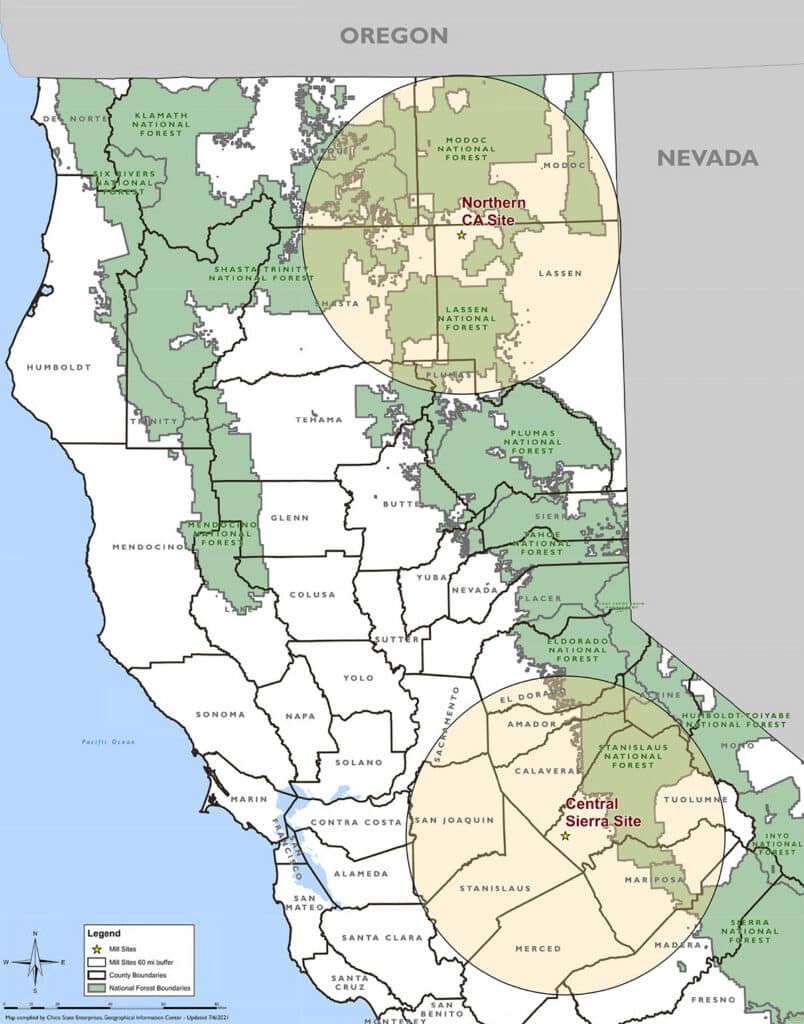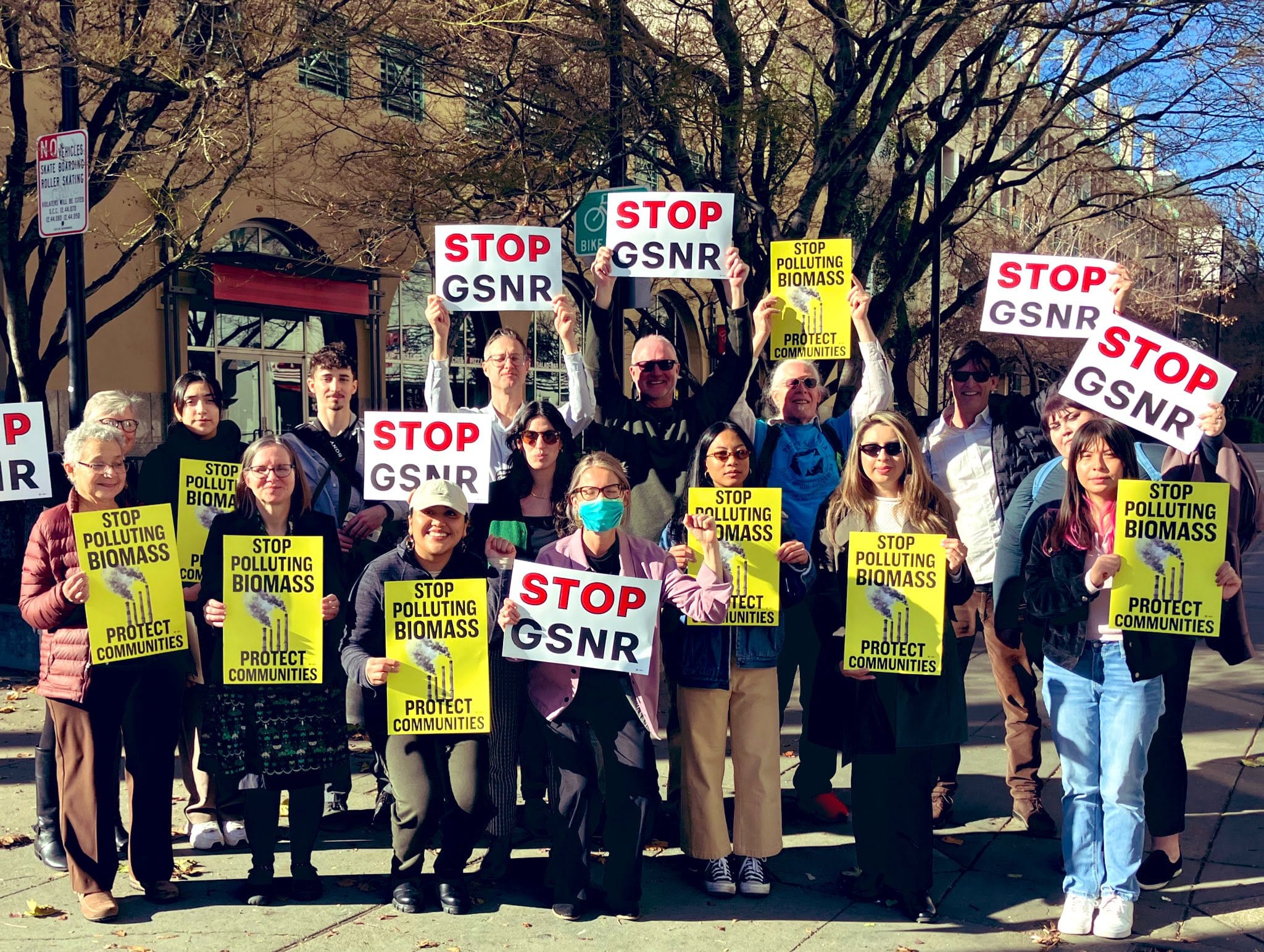Guest article By California resident Gary Hughes, Biofuelwatch
Recent developments in California offer another clear indication that Bioenergy with Carbon Capture and Storage (BECCS) cannot be relied upon as a Carbon Dioxide Removal (CDR) strategy.
California legislators embrace CDR
Over the last decade, California climate and land management authorities have turned hard towards promoting the ‘utilization of woody biomass’ as a preferred pathway for achieving carbon emissions reduction goals. Over time, this focus in the state capitol of Sacramento on bioenergy came to include the now oft-repeated vision for burning forest biomass to generate electricity and then capturing the carbon emissions as a means of creating ‘carbon neutral’ energy.
Elevating such technology has become commonplace in California. For example, the California Air Resources Board (CARB) 2022 Scoping Plan specifically promotes BECCS as a carbon removal technology that is inherent to the future attainment of the state’s ‘net zero’ emissions goals.
However, a closer look at the past, present and future of BECCS in California exposes the folly of such endeavors. The recent failure of a proposal to bring an export-oriented wood pellet sector to California exposes the global unviability of BECCS schemes. At the same time, it serves as a sobering reminder of the persistent narratives in California that promote speculative CDR technologies as a meaningful response to climate change, despite abundant evidence of their known environmental harms and threats to public interest.

GSNR pull the plug on their wood pellet export plans
As a case in point, a couple of weeks ago, the board of directors of the California-based nonprofit organisation Golden State Natural Resources (GSNR) gathered in the far northern Modoc County seat of Alturas. On the GSNR board meeting agenda was an item discussing the future of the wood pellet export mega project that had been central to their mission over the last several years.
In a shock move celebrated across the environmental movement, the board voted unanimously to shelve the organization’s planned wood pellet manufacturing and export project. Though the board expressed optimism at the prospects of their business eventually providing feedstock for domestic energy uses – including BECCS – their spin about future wood chipping operations could not hide the global significance of their pulling the plug on making wood pellets and shipping them to markets in Asia and the UK to burn in power stations alongside or in place of coal.
Drax eyes California investments
Notably, GSNR has been working closely on project development with the UK-based Drax, which operates the world’s largest biomass power station, as well as numerous industrial wood pellet manufacturing mills across the US and Canada. Drax is currently seeking public subsidies to install two carbon capture units at its UK power station, and Drax burns more US-sourced wood pellets than any other power station in the world. Drax has also publicly discussed plans to construct a BECCS plant in California, even advocating before CARB the imperative of developing BECCS technology. However, as of yet, nothing concrete has emerged regarding Drax’s California BECCS plans.
As it stands, GSNR and Drax officially signed a memorandum of understanding in early 2024 to collaborate in project development, confirming what global climate justice advocates had anticipated, that Drax had indeed been lurking behind the GSNR wood pellet export scheme, and was likely hungry for wood pellet biomass to feed their business and even serve as feedstock for their BECCS technology, whether it be in the UK or the USA.
Some history on GSNR provides a backstory on California dabbling in breaking into the global wood pellet industry. It was during the summer of 2022 that Biofuelwatch first identified the GSNR proposal to build two new wood pellet manufacturing facilities in rural California to produce one million tons of wood pellets a year for export to global energy markets through ports in the San Francisco Bay Area. These new industrial facilities, one in Lassen County making 700,000 tons of wood pellets a year and the other in Tuolumne County making 300,000 tons a year, were to be the largest forest product manufacturing plants sited and constructed in California in decades.
Sourcing feedstock for making one million tons of wood pellets a year would have been a dramatic expansion of forest harvest activities for industrial wood product manufacturing in the state. The significance and scale of this proposed establishment of the global wood pellet sector in California was also reflected in the conservatively estimated $500+ million dollar investment required for the construction of the two new wood pellet plants, as well as a storage and export facility in Stockton, from which the wood pellets would be shipped out to global markets.

Stockton community rallies
Stockton is already host to a legacy dirty biomass plant owned and operated by Michigan-based DTE Energy. That DTE biomass plant is just one in a long list of environmental stressors affecting the Stockton area.
The discriminatory treatment of Stockton by GSNR as a project facility location was only accentuated by the manner in which the GSNR board of directors was convening their critical June 2025 board meeting in remote Modoc County, without any means of virtual or phone attendance, or of even viewing a broadcast of the meeting. In other words, GSNR was once again making decisions that would impact Stockton, but without traveling to Modoc County, residents of Stockton would be hard-pressed to know exactly what would have been decided.
Considering the quasi-public nature of GSNR, the decision not to broadcast the meeting on a widely available online platform was purposeful, and out of the ordinary in 2025, even for a remote rural California county.
The halting of a massive wood pellet export project that was directly associated with the UK climate villain Drax was immediately embraced by forest defenders and community protectors around the world
A trip up to Modoc County
Observing these dynamics in the run-up to the meeting, Biofuelwatch assessed that attendance at the Alturas meeting was an imperative to know factually what GSNR, and their partner Drax, were deciding about the future of a wood pellet industry in California. We therefore made the trip with allies to be at the meeting in Modoc County in the northeast corner of the state to hear first hand what GSNR was going to do about the hinted ‘changes’ coming to their project. It did not take long to find out.
In an extremely short and efficient meeting that featured a presentation from GSNR staff about their analysis that the wood pellet proposal was no longer their preferred option, the board of directors rapidly and without any deliberation made and seconded a motion, voted on the motion, and confirmed the decision to shelve their aggressively publicized vision to bring the global wood pellet sector to California.
Critical to the decision was the complete abandonment of the wood pellet storage and export terminal in Stockton. For a community already confronting a multitude of environmental injustices, the decision by GSNR to abandon its wood pellet export scheme was rightly perceived as a clear victory for Stockton neighbors.
Anticipating the industry’s next move
The halting of a massive wood pellet export project that was directly associated with the UK climate villain Drax was immediately embraced by forest defenders and community protectors around the world as an important turn of events that hints at the growing momentum to stop the expansion of the wood pellet industry and hold players like Drax accountable for their legacy of environmental and social harms.
Stopping the GSNR scheme to work with Drax to bring the wood pellet sector to California might not be a tide change, but it does shake up the discourse about bioenergy and so-called ‘negative emissions
GSNR deciding to abandon its wood pellet export scheme is a notable victory against an industry that has, over the last decade, exploited the false narratives around biomass as renewable energy to expand their sector and production with impunity.
At the same time, Drax continues to network and lobby in California to maintain high-level access to the political interests that promote the development of markets and technology-based responses to climate change. The USA subsidiary of Drax, Elimini, has even succeeded in securing a spot in the governance of high-profile California-based organizations such as The Climate Registry. Laurie Fitzmaurice, the CEO of Elimini, currently serves as the Vice-Chair of the Board of Directors of The Climate Registry, where California climate policy big leaguers like Mary Nichols, former Chair of CARB, also serve. Drax has clearly understood the value that global transnational energy corporations have placed on Sacramento for decades. As California leads, the world follows. Setting precedent in California on elevating market mechanisms and speculative technologies as a response to climate change creates favorable conditions for polluters everywhere.
Nevertheless, the grassroots continues to secure wins in pushing back on climate scams that will only make the climate and biodiversity crises worse. Stopping the GSNR scheme to work with Drax to bring the wood pellet sector to California might not be a tide change, but it does shake up the discourse about bioenergy and so-called ‘negative emissions.’
Even as coalition participants take stock of how to monitor and respond to GSNR aspirations to reinvent their biomass project, whether it be to pursue bioenergy unicorns like making aviation fuel or hydrogen from woody biomass, we will not be shy about heralding the significance of this victory in California over the global wood pellet sector, and the clear evidence that this turn of events provides regarding the unrealistic objectives and incontrovertible harms that would arise from the pursuit of BECCS as a global climate strategy.



